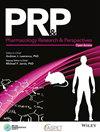Risks of oral anticoagulants: Analysis of adverse drug reactions reported to the Portuguese National Pharmacovigilance System
IF 2.9
4区 医学
Q2 PHARMACOLOGY & PHARMACY
引用次数: 0
Abstract
Cardiovascular diseases are the leading cause of death globally, making the use of oral anticoagulants for prevention increasingly important. Historically, warfarin has played a significant role in this context. In recent years, introduction of new oral anticoagulants, such as rivaroxaban, apixaban, dabigatran, and edoxaban, has been seen. This study evaluates the risk associated with the use of oral anticoagulants by analyzing spontaneous adverse drug reactions reported to the Portuguese Pharmacovigilance System from 2012 to 2021. The study includes 951 adverse drug reactions reports, with the majority (口服抗凝剂的风险:向葡萄牙国家药物警戒系统报告的药物不良反应分析
心血管疾病是导致全球死亡的主要原因,因此使用口服抗凝剂进行预防变得越来越重要。一直以来,华法林在这方面发挥着重要作用。近年来,利伐沙班、阿哌沙班、达比加群和埃多沙班等新型口服抗凝药物相继问世。本研究通过分析 2012 年至 2021 年葡萄牙药物警戒系统报告的自发性药物不良反应,评估了使用口服抗凝剂的相关风险。研究包括 951 份药物不良反应报告,其中大部分(n = 770;80.97%)被归类为严重不良反应。在 770 份严重药品不良反应报告中,最常报告的严重性标准是 "临床重要"(n = 350;45.45%)。从人口统计学来看,老年人群的报告率较高,女性的报告率也较高。药物不良反应数量最多的系统器官类别是 "胃肠功能紊乱",最常报告的首选术语是 "胃肠道出血",达比加群是最常报告的药物。总之,口服抗凝药存在药物不良反应,需要持续监测。准确识别和监测药物不良反应是提高人群用药安全的重要起点。
本文章由计算机程序翻译,如有差异,请以英文原文为准。
求助全文
约1分钟内获得全文
求助全文
来源期刊

Pharmacology Research & Perspectives
Pharmacology, Toxicology and Pharmaceutics-General Pharmacology, Toxicology and Pharmaceutics
CiteScore
5.30
自引率
3.80%
发文量
120
审稿时长
20 weeks
期刊介绍:
PR&P is jointly published by the American Society for Pharmacology and Experimental Therapeutics (ASPET), the British Pharmacological Society (BPS), and Wiley. PR&P is a bi-monthly open access journal that publishes a range of article types, including: target validation (preclinical papers that show a hypothesis is incorrect or papers on drugs that have failed in early clinical development); drug discovery reviews (strategy, hypotheses, and data resulting in a successful therapeutic drug); frontiers in translational medicine (drug and target validation for an unmet therapeutic need); pharmacological hypotheses (reviews that are oriented to inform a novel hypothesis); and replication studies (work that refutes key findings [failed replication] and work that validates key findings). PR&P publishes papers submitted directly to the journal and those referred from the journals of ASPET and the BPS
 求助内容:
求助内容: 应助结果提醒方式:
应助结果提醒方式:


